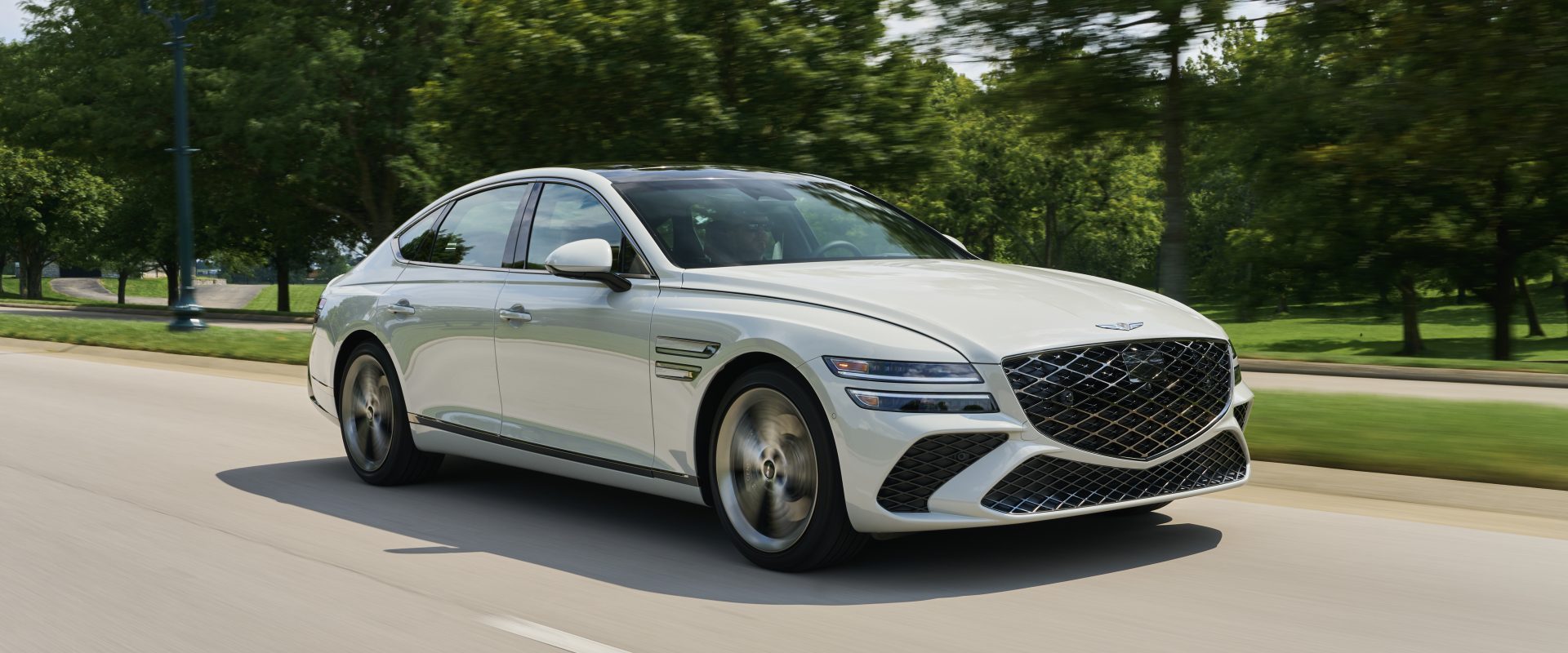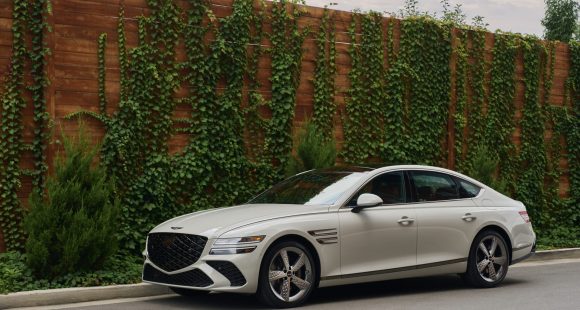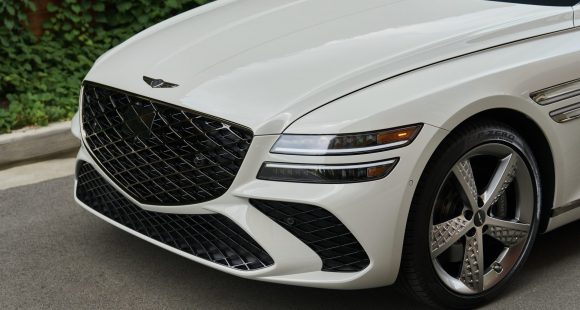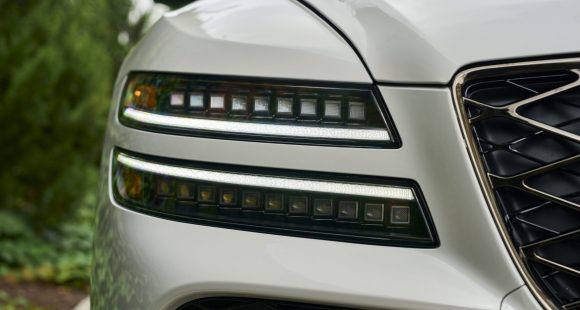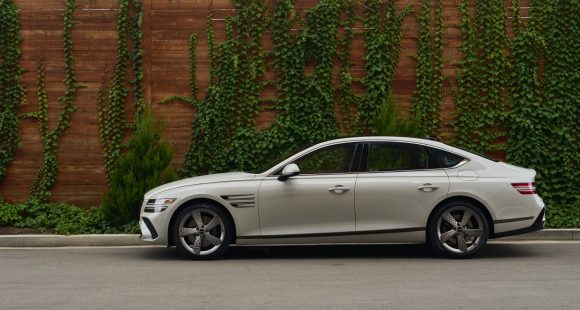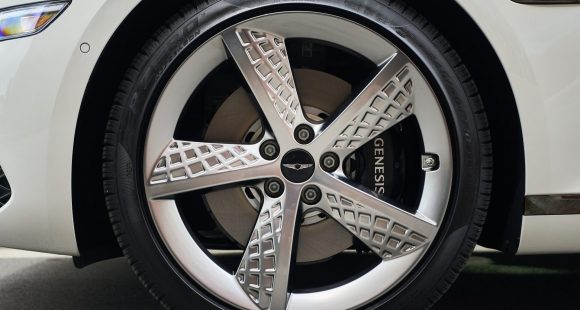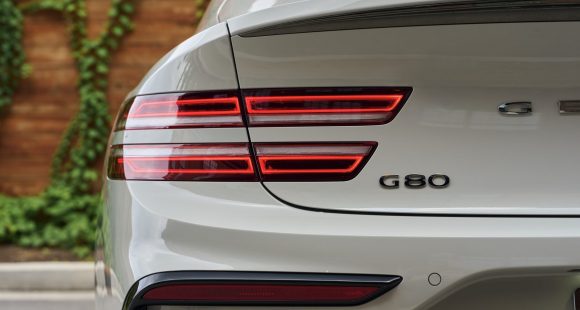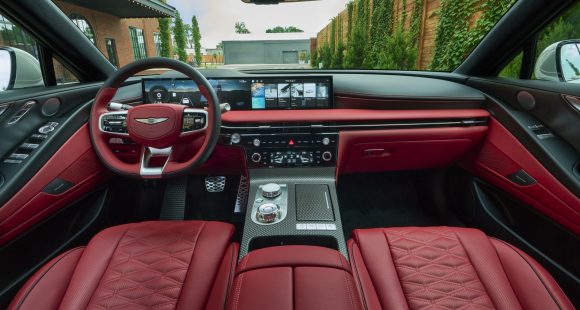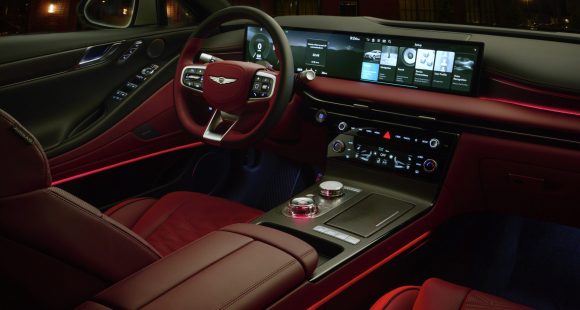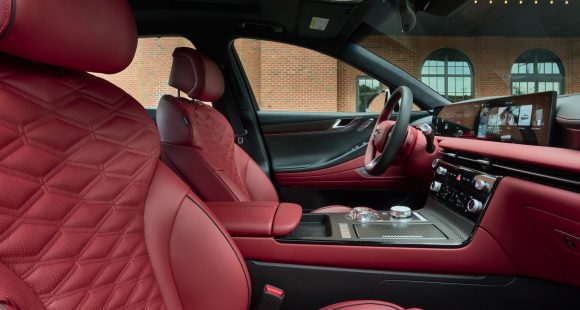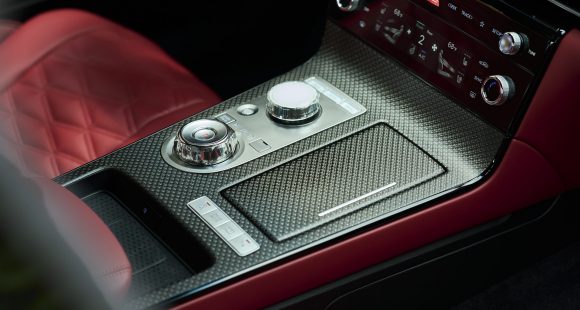2011 Jaguar XJ
Even before their divorce from Ford, Jaguar was transforming its cars from a classic grand touring image of the 20th century to a British showcase of sophisticated motoring for the 21st century. Now, the mid-size XF sedan set the stage, but everyone knew the make-or-break star would be the top-tier XJ saloon. Now, our first impressions were very positive. So let’s have a complete critique.
The all-new 2011 Jaguar XJ follows the XF into a bold new world of styling for this classic brand. Aside from grille texture and badging, Design Director Ian Callum has left nary a hint of the previous XJ, choosing to go back further for inspiration. Instead of the familiar four-orb headlights, two swept-back cats-eye lamps are set in low, sculpted fenders. But XJ heritage is still sensed in the rounded-off grille and long hood that date back to the original 1968 Series I.
With so much sloping glass, there is very little trunklid. Blacked-out C-pillars are definitely an eclectic touch. LED taillights pour down the XJ’s elegantly simple, tapered tail, adorned only with a chrome Leaper.
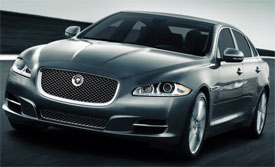 The mid-size XF’s potent trio of 5.0-liter direct-injected V8s provides plenty of go for the larger XJ as well. Base unit is naturally aspirated with 385 horsepower and 380 pound-feet of torque. The Supercharged XJ’s belt-driven breathing is good for a stout 470 horses and 424 pound-feet.
The mid-size XF’s potent trio of 5.0-liter direct-injected V8s provides plenty of go for the larger XJ as well. Base unit is naturally aspirated with 385 horsepower and 380 pound-feet of torque. The Supercharged XJ’s belt-driven breathing is good for a stout 470 horses and 424 pound-feet.
The special-order Supersport adds the 510-horsepower eight from the XFR. The only transmission, a six-speed automatic, presses the hockey puck-JaguarDrive Selector into your palm at startup. There are also wheel-mounted paddle shifters, and driver selectable Dynamic mode that holds gears longer while also firming up the suspension and seat belts!
With a mean growl, our 385-horse XJ leaped from 0 to 60 in 5.8 seconds, and raced through the quarter mile in 14.3 seconds at 103 miles per hour. It does bog down momentarily at launch. Without that, times would be even faster. Still, results closely match the XF, thanks to the aluminum chassis that allows the XJ to enter the ring some 300 lbs lighter than its rivals.
That chassis is supported by standard air suspension with continuously variable damping. Driving aids include the expected stability and traction control, plus an active rear differential. The combo makes for a supple ride and sublime handling-once you get used to the quick but dead steering, that is. The lack of feedback reminded us of a video game. But, get the hang of it, and this big Jag easily mastered every corner we threw at it. Yes, it rolls a bit, but overall it is well balanced and unflappable.
But you always know what the brakes are doing. An initial soft pedal is followed by good bite. A 131 foot average coming down from 60 could be shorter, but stability is excellent and the experience is far smoother than most rivals.
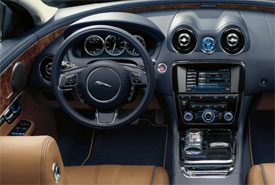 And, no rival can match the way Jaguar dresses its interiors. Wood veneer rings a spacious, amazingly well equipped cabin, whose low-slung leather dash is shrink-wrapped around nautical-style vents.
And, no rival can match the way Jaguar dresses its interiors. Wood veneer rings a spacious, amazingly well equipped cabin, whose low-slung leather dash is shrink-wrapped around nautical-style vents.
Classic round gauges reside in a virtual world, as a driver-focused 12.3-inch display fades up at startup, highlights critical data, and tints red in ‘Dynamic’ mode.
A center eight-inch Dual View touch screen allows the driver and front passenger to view two different visuals at the same time. It fits right below a classic analog timepiece.
Very modern is the standard panoramic glass roof. There’s ample storage, including Jaguar’s one-touch opening glovebox, and very usable cupholders in the center console. In the rear, leather covers the seats, door panels, and even the headliner is suede cloth. While there is plenty of room, long wheelbase models expand it to limousine proportions. The Jaguar’s 18.4 cubic feet of trunk volume is decent, though less than Mercedes’ S-Class.
Government Fuel Economy for our XJ are 16 city/23 highway on premium fuel. We hit a respectable 20.0 miles per gallon in real world driving. The new XJ has a base price of $72,500, which makes Jag’s flagship a segment bargain. The supercharger adds $15,000 more, with the SuperSport in six figures. On all, the long wheelbase tacks on a few grand additional.
The 2011 Jaguar XJ bridges the gap between two eras beautifully. Never once do classic inspirations and eclectic touches mar the totally modern outcome in the slightest. With extroverted style and performance aplenty, Jaguar’s big cat roars into the 21st century with its claws out.
Specifications
- Engine: 5.0-Liter Direct-injected V8
- Horsepower: 385
- Torque: 380 Lb Feet
- 0-60 MPH: 5.8 Seconds
- 1/4 Mile: 14.3 Seconds @ 103 MPH
- 60-0 MPH: 131 Feet
- EPA: 16 MPG City/ 23 MPG Highway
- Mixed Loop: 20.0 MPG
2025 Genesis G80
New Interior And New Tech Elevates G80 Sedan
Talk about bad timing. This second-generation G80 debuted at the height of a global pandemic. But that hasn’t stopped Genesis or this Bentley-on-a-budget sedan. In fact, since then, Genesis has unveiled a spectacular all-electric version and now given all G80s a makeover. So, let’s find out what a better and better-timed new G80 is ready to deliver.
Breaking into the luxury sedan scene requires going up against traditional brands with long pedigrees and legions of loyal buyers. But Hyundai has never shied away from a challenge, and has made steady progress with their Genesis brand, and hopes that a revised 2025 G80 midsize sedan will be their next step up.
Styling matters more when you’re the upstart, and the Genesis Athletic Elegance theme changes very little for ’25; just a new grille, slightly reshaped bumpers, new wheels ranging from 18 to 20 inches, and an updated color palette. The G80’s unique two-line LED headlamps get revised Micro Lens Array technology that boosts performance while minimizing the brightness for oncoming drivers.
Changes inside are much more significant with an entirely new dash and console, eliminating both the hooded gauge panel and dashtop wide info screen. Merging them together into one 27-inch wide LG panoramic display than runs from behind the steering wheel to over the center stack. There’s a bigger and more comprehensive control panel in the center stack; while the console gets less armrest coverage, more space for storage, and reshaped cupholders. The wider display is still a touchscreen, but there is also a console mounted controller if you prefer to keep it fingerprint free. Both options work well, but the controller is still too easy to confuse with the dial-like shifter.
Materials are on par if not a notch above most European luxury rivals, and there are 18 speakers to crank out 1,400 watts of premium sound from Bang & Olufsen. Top Sport Prestige trim comes with Nappa leather seats, carbon fiber trim, micro-suede materials for the headliner and pillar covers, heated armrests, head-up display, and upgraded active safety features. Front seats are immensely comfortable without feeling overly soft, and there’s plenty of comfort and room for adults in the back seat.
More Bentley than Benz; streaking down the track with European-style solidity that gives you very little indication of the high speed you’re traveling at.
Same powertrains as last year. Base power comes from a 300-horsepower 2.5-liter turbo-four; the upgrade is this 3.5-liter twin-turbo V6 that outputs 375 horsepower and 391 lb-ft of torque. Both are hitched to standard all-wheel drive. At our Mason Dixon Dragway test track, the AWD delivered enough grip for consistent slip-free launches. We hit 60 in 5.0 seconds flat. Run after run, the 3.5T pulled as strong as it sounds. All G80s work with the same paddle-shift eight-speed automatic transmission, and while shifting was silky smooth on the street, here on the track with Sport Mode and wide-open throttle they were noticeably firmer and quicker.
It was a very surreal experience in the cabin. More Bentley than Benz; streaking down the track with European-style solidity that gives you very little indication of the high speed you’re traveling at. For us, that was 105 mph in 13.4 seconds at the quarter. In addition to the G80’s Sport Mode that tightens steering, improves throttle response, adjusts shifting points, firms up the suspension, and reconfigures stability system parameters; Sport Prestige trim adds rear-wheel steering and an electronic limited slip differential. But, even with all of that, it didn’t feel overly sporty in our handling course. Now, we were able to comfortably carry quite a bit of speed through the cones, but there was just an overall soft, somewhat disconnected and heavy presence that had us unsure of how hard we could push. Sport Prestige also adds upgraded performance brakes. They were plenty capable, bringing this 4,600-lbs. luxury liner consistently down from 60 in just 104 feet with little fade.
Government Fuel Economy Ratings for the six-cylinder are 16 City, 24 Highway, and 19 Combined. We averaged a good 21.3 mpg of Premium. Still, that’s a slightly below average Energy Impact Score, using 15.7 barrels of oil annually with 7.8 tons of CO2 emissions.
Considering the amount of luxury packed into the G80, its $58,350 starting price, even though slightly higher than last year, remains pretty remarkable. It’s a substantial step up to the 3.5T though, as it begins at $70,850.
Genesis has existed as a standalone luxury brand for just less than a decade, and it has indeed been making steady progress into what is surely the hardest segment of all to master. The 2025 Genesis G80 sedan continues to impress and is a great option for luxury-minded buyers who prioritize true value over badges.
Specifications
As Tested
- Engine: 3.5-liter twin-turbo V6
- Transmission: eight-speed automatic
- Horsepower: 375
- Torque: 391 lb-ft
- EPA: 16 City | 24 Highway | 19 Combined
- 0-60 mph: 5.0 seconds
- 1/4 Mile: 13.4 seconds at 105 mph
- Braking, 60-0 (avg.): 104 feet
- MW Fuel Economy: 21.3 mpg (Premium)







